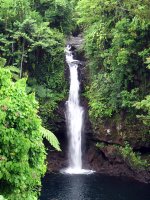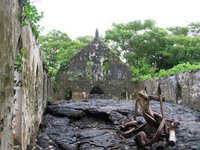
After a particularly long (but definitely enjoyable!) Christmas Day, I managed to get out of town for a couple of days with a couple of friends. We were able to escape to the comparative calm and quiet of
Namu'a island, a small island off the south-east point of
'Upolu (the main island of Samoa, the other large island being
Savaii). With just a single beach (really just a splash of sand) and a handful of
fales sitting just behind it, Namu'a is tiny. It's the perfect place to go and hide from the rest of the world.
The waters around Namu'a are a popular feeding ground for sea turtles. On the boat over to the island we spotted a giant one, gliding effortlessly and gracefully through the crystal clear water. Very amazing.
Whilst there, I can safely say all I managed to do was go snorkeling, eat the occasional meal and sleep. Oh, that and meet the most domesticated pig I've encountered in Samoa.






